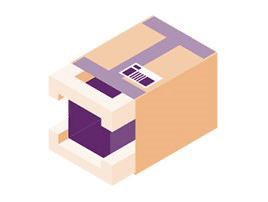
Nov 21, 2025 • by Paul Bourque
How to ship a package from Canada to Germany
Certain goods shipped to Germany have restrictions and all parcels require a shipping label, commercial invoice, and may incur duties and taxes


by Alex McOmie
Oct 16, 2017
Key Points

Making sure your goods are well-protected during shipping is always important, but when valuables are involved, you want to be completely sure that you’re doing everything you can to get them to their destination securely. In order to mitigate risk to the fullest extent possible, there are a few things you should know before you ship. We’ll look at the most important aspects of shipping valuables, safe packaging and insurance.
If you regularly ship important goods, you should have a routine for packing them securely. Different types of items often require different packing methods, but it’s good to follow some basic guidelines. Start with these tips from UPS:
1. Pack your items in a new corrugated box

2. Use at least 2 inches of adequate cushioning material

3. Securely seal package and affix completed label

First, you’ll want to find the right box for what you’re shipping. In general, try to use one that leaves a gap of about two inches between the item and box—by filling the remaining space with polystyrene peanuts or a similar buffer, you’ll minimize any direct impact on what you’re trying to protect. Additionally, you should be sure that the box is going to be able to support the item throughout the shipping process.
Packaging items to meet the ISTA 3A standardIt’s extremely important to surround your goods with materials that will cushion them from damage and wear. Peanuts will fill the empty space in the box, but the items themselves should also be wrapped. The best material for this is small cell bubble wrap, especially if you use multiple layers. One good strategy is to do a layer or two of small cell, and then add large cell bubble wrap around that. For more detailed information on the best materials for packaging, check out our article Handle With Care - Shipping Fragile Items.
Again, there’s no one-size-fits-all approach to packaging, so try to adjust for your specific situation. If you’re unsure of the best option, the UPS Packaging Advisor is a great resource which gives recommendations based on the items along with size and weight. Packaging your valuables as securely as possible is the first and most important step in shipping them safely. If you have any doubt that you’ve packaged your items properly, contact a professional or expert.
No matter how careful you are with your package, you won’t eliminate the possibility of something going wrong. Chances are, you’ll eventually have an item damaged, lost, or destroyed during shipping, and the best way to counter that risk is with shipping insurance. We’ll cover some of the basics here, but you can also check out our article The Fine Print of Carrier Insurance.
However, there are some concerns here, and you’ll want to have all the information before making a decision about what carrier to ship with and how to cover your items. Make sure to read all the relevant information on your carrier’s website, and compare the available options.
If you end up making a claim, it’s not as simple as collecting a check for the value of the items. The carrier will likely inspect the package, and if they find that it was inadequately packaged, they won’t cover the damage. Generally, carriers expect you to package your goods to the ISTA 3A standard. For this, you’ll need at least two inches of padding surrounding your items, and a box strong enough to support and carry the contents. This video, which illustrates the ISTA 3A test, should give you an idea of how resilient your package needs to be.
Each carrier has different rules regarding insurance, but if you’re shipping highly valuable goods, you’ll often have to pay extra for coverage over a certain minimum. USPS, for example, covers up to $50 or $100 by default depending on the package. If you need more than that, you’ll have to pay, and coverage is only available up to $5,000. However, other carriers, such as UPS and FedEx, allow you to insure your items for up to $50,000.
Each carrier considers certain items uninsurable, or further limits the amount of coverage available. FedEx, for example, only allows items such as art, antiques, or film, to be declared at a value of up to $1,000. It’s important to check your carrier’s terms and conditions before trusting them with your goods—better safe than sorry! It’s worth switching carriers or paying extra to get the peace of mind that comes from knowing you’re covered. If costs go up because of insurance, our article 5 Ways Small Businesses Can Save Money On Shipping Expenses can help you find other ways to save money while shipping.
For more information on shipping insurance, the best place to start is with the carriers themselves. These links will help you compare the pros and cons of some of the more popular options:
If your preferred carrier has restrictions on insurance for items that you plan to ship, you have a few choices. You can always switch to a carrier who will insure those goods, but there are also third-party insurers who will allow you to ship the same way you usually do.
Shipsurance is a popular third-party insurance company, with options such as monthly, flat-rate coverage. It can be used with most major carriers, including FedEx, UPS, DHL, USPS, and Canada Post, making it easy to integrate with your existing shipping routine. While Shipsurance is far from the only available outside option, this table should give you an idea of what you could save by switching to third-party insurance.
| Carrier and Service | 2017 Cost |
|---|---|
| FedEx Domestic and International | Included up to $100 value $100 and above: $3.50 per additional $100 |
| UPS Domestic and International | Included up to $100 value $100 and above: $2.95 per additional $100 |
| CanadaPost | Included up to $100 value $100 and above: $2.25 per additional $100 |
| Purolator | Included up to $100 value $100 and above: $4.50 per additional $100 |
| USPS Domestic | Value of $0-50: $2.10 $50-100: $2.65 $100-200: $3.35 $200-300: $4.40 $300-400: $5.55 $400-500: $6.70 $500-600: $9.15 $600-5000: $9.15 plus $1.25 per additional $100 |
| USPS International | Depends on service |
| Shipsurance | Variable rates depending on your business’s “shipping volume, valuation, commodity, and claims history” |
Whatever you choose, follow the advice above to ensure that any potential claims won’t be denied. There are some other steps to giving yourself peace of mind. As part of your claim, you’ll need to provide proof of value, a document showing that the insured items are worth as much as you declared. A sales receipt or similar document will suffice. You should also take pictures of each item before shipping and keep them on hand until the package has been received safely. Again, it’s best to check with your specific carrier (or outside insurance company) for more details.

Nov 21, 2025 • by Paul Bourque
How to ship a package from Canada to Germany
Certain goods shipped to Germany have restrictions and all parcels require a shipping label, commercial invoice, and may incur duties and taxes

Nov 17, 2025 • by Paul Bourque
How much does it cost to courier from Canada to France?
Many variables combine to determine the cost of shipping – delivery time, parcel size, and time of year, but Secureship always makes it cheaper for you

Nov 14, 2025 • by Paul Bourque
How much does it cost to send a package to Japan?
For a two-business-day delivery, rates to Japan can reach $500 for a light, modest parcel, but a lot less if the delivery time is extended